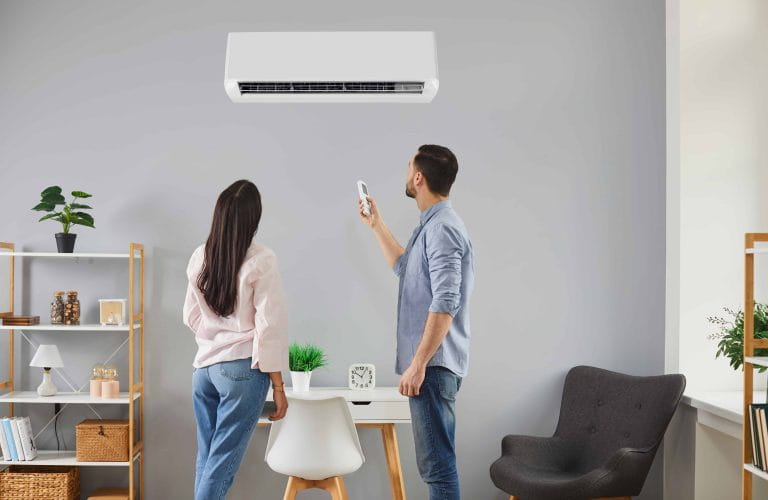We turn on the air conditioner and wait for the awaited refreshment, but we are left disappointed. Something is wrong: instead of cold air, warm air comes out. Let's try to understand why it happens and how to fix it.
Why isn't cold air coming from the air conditioner?
An air conditioner and hot air make a strange combination. The goal of the unit is to cool the environment, bringing relief to the home’s inhabitants. Unfortunately, issues can arise: for instance, too much condensation can form, preventing it from functioning properly. Or it may run out of the refrigerant gas: this could be one of the main reasons why the air conditioner is no longer cooling.
- When the refrigerant gas level drops below what is required for the unit to operate, the cooling effect vanishes.
- It is necessary to refill the gas, a task that must be carried out by a specialised technician.
- The technician will also be able to identify any leaks or damage in the system.
Another possible reason could be an issue in the indoor unit, commonly known as the split, from which the airflow originates.
- First, the filters may be clogged due to lack of maintenance over the years and the accumulation of dust.
- This blocks the airflow, preventing cold air from coming through because of the barrier created over time.
- While filter cleaning is relatively simple and can be done by the user, a technician’s expertise is required to identify issues with the internal fan of the split, which is responsible for generating the air stream.
- Dust or mould buildup can obstruct the fan's performance: even if the fan is spinning, the air doesn’t move, and the room doesn’t cool down.
The issues may not only lie in the indoor unit but also in the outdoor unit, which is particularly exposed to weather conditions.
What to do if the air conditioner does not cool?
The outdoor unit is the part of the air conditioner that is installed on the exterior wall of the house. It is an essential part of the whole system, as it expels the heat captured inside the house into the outdoor environment.
However, this heat exchange can become difficult, if not impossible, when the unit is very dirty due to leaves and dust being sucked in while it is operating.
Maintenance operations include inspecting and cleaning the outdoor unit, which houses a fan and the generator’s motor. Faults in these components make it impossible for the air conditioner to achieve the desired indoor temperature, especially when the heat outside becomes unbearable.
What to do if the air conditioner does not heat
An opposite scenario to the one previously described is when you want to heat a room using the heating mode of your air conditioner during the cold season, but it does not work.
First, it is important to clarify that while most air conditioners only produce cold air, air conditioning units have additional functionalities like heating and dehumidification. Even though the two terms are often used interchangeably, the difference is clear.
More advanced and high-performing air conditioners are equipped with integrated heat pump technology. They draw air from inside the room, which is heated through a special exchange coil and then released as warm air. This same technology allows the unit to regulate the output of hot or cold air, depending on the need, and to manage the temperature of the environment we want to heat or cool.
If the air conditioner isn’t heating, there could be several reasons:
- The remote control is set incorrectly. It needs to be on heating mode, often represented by a sun icon or labelled with a word like “heat.”
- The filters are dirty due to dust buildup, which is the same reason that can block cold air from coming out.
- Issues with the outdoor unit can hinder normal functioning. Sometimes, a simple cleaning to remove obstacles and dirt is enough.
- If you don’t hear the fan running when the air conditioner is on, the issue might be more serious.
The heating effectiveness of the air conditioner also depends on two other factors:
- the dimension of the room;
- insulation
If the installed unit is not powerful enough for the size of the room, it becomes more difficult to achieve thermal comfort, leading to increased energy consumption and higher bills.
Just like with winter heating, worn or low-quality windows contribute to heat loss, making any attempt to warm the house ineffective.
How do I know if the air conditioner is running out of refrigerant gas?
Given the crucial role of refrigerant gas, there are some signs to help you understand when its level has dropped, causing the air conditioner to underperform.
A clear indication is the formation of ice or frost on the pipes that connect the outdoor unit to the indoor unit.
Latest-generation models are equipped with sensors to monitor the gas level in the system. When it drops too low, a warning will appear on the display of the unit, the remote control, or the device used to manage it remotely if it has smart home integration for interaction via smartphones and tablets.











































